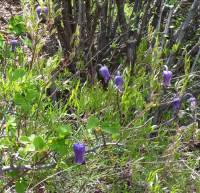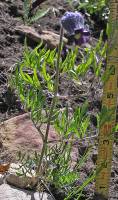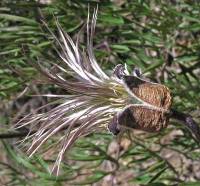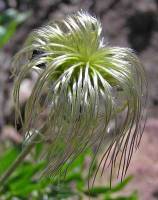Stems erect, not viny, 1.5-6.5 dm, hirsute (sometimes sparsely so in var. hirsutissima ) or densely short, soft-pubescent to nearly glabrous. Leaf blade 2-3-pinnate; leaflets often deeply 2-several-lobed, if lobed than lateral lobes usually small and distinctly narrower than central portion, leaflets or lobes linear to lanceolate, 1-6 × 0.05-1.5 cm, thin, not prominently reticulate; surfaces sparsely to densely silky-hirsute, not glaucous. Inflorescences terminal, flowers solitary. Flowers broadly cylindric to urn-shaped; sepals very dark violet-blue or rarely pink or white, oblong-lanceolate, 2.5-4.5 cm, margins narrowly expanded distally, 0.5-2 mm wide, thin, distally ± crisped, tomentose, tips obtuse to acute, slightly spreading, abaxially usually densely hirsute, occasionally moderately so. Achenes: bodies densely long-pubescent; beak 4-9 cm, plumose.
The varieties of Clematis hirsutissima , although highly dissimilar in their extreme forms, intergrade extensively in Wyoming, Colorado, and Utah.
Duration: Perennial
Nativity: Native
Lifeform: Subshrub
General: Perennial, 15-65 cm tall; stems erect, usually simple, often slightly woody at the base, sparsely hirsute; rhizomes elongate.
Leaves: Cauline, opposite, 2-3 times pinnate, with 7-13 primary leaflets (or sometimes not distinctly differentiated), leaflets and ultimate divisions narrowly lanceolate to narrowly linear, 1-6 cm long, 0.5-6 mm wide, surfaces nearly glabrous to densely silky-hirsute; blades petiolate.
Flowers: Inflorescence of 1-2 flowers; flowers radial, 1.5-4 cm in diameter; sepals broadly oval to narrowly obovate, 8.5-23 mm long, white to yellow, bluish below; petals absent; stamens numerous; flowers June-September.
Fruits: Aggregate of achenes, flattened, 4-6 mm long, the body densely long pubescent; beak 4-9 cm long, feathery.
Ecology: Meadows, ponderosa pine forests, montane habitats, open woods, thickets; 2000-2600 m (6500-8500 ft); Apache and Coconino counties; western and southwestern U.S.
Notes: Ours, as here described, is var. hirsutissima [C. hirsutissima var. arizonica]. Clematis bigelovii (Bigelow-s clematis) is similar, but differentiated by its leaflets usually more than 1.5 cm wide, mostly less than 2.5 times as long as wide, mostly lobed, the lateral lobes are often nearly as wide as the central portion, blade glabrous or nearly so; and beak of achene is 2-3 cm long, glabrous or inconspicuously appressed-pubescent. It occurs in moist habitats and on mountain slopes. Although locally more common in New Mexico, plants have been documented in eastern Arizona.
Editor: Springer et al. 2008










